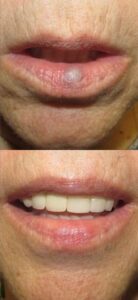
Vascular laser can eliminate or drastically improve the appearance of unwanted red or blue blood vessels on the face, eyelids, or nose. Venous lakes, bluish colored vascular lesions commonly found on the lips, also respond very nicely to laser treatment. Dr. Biesman or his staff will advise you whether your particular concerns are best addressed with lasers or other techniques.
Typical Outcomes for Laser Treatment of Vascular Lesions
The typical outcome when treating red facial vessels is immediate disappearance without bruising or crusting. One to three treatments are usually required, with three to four weeks recommended between treatments. It is extremely important that your skin overlying the unwanted vessels is not tanned. Laser treatment of tanned skin places one at higher risk for complications such as discoloration or scarring. Your skin must be at its normal, baseline color before you undergo treatment for unwanted blood vessels.
What to Know about Treatment of Facial “Broken Capillaries”
- Treatments are performed in the office without the need for anesthesia.
- After treatment, most patients experience only mild redness that lasts for one to two days. Crusting can occur in the treatment area but this is relatively uncommon. Should crusting occur following your laser treatment, it typically resolves within a few days to two weeks.
- While the treated vessels usually do not recur, patients who have the tendency to develop unwanted blood vessels in their skin will likely do so again in the future. Periodic maintenance treatments are usually recommended.
- Scarring after laser treatment of facial or leg veins is very uncommon but can occur. Should you experience this, additional laser treatments using other devices and /or subcision may be recommended to achieve the best outcomes.
Leg Vein Management
For leg vein management, injection (sclerotherapy) and surgical removal of veins via ambulatory phlebectomy are the first lines of approach for treating larger veins. In other words, lasers, injections and surgery are all complementary as opposed to mutually exclusive treatments. Many patients require a combination of these treatments to achieve the best results. Dr. Biesman does not perform non-laser services for leg vein treatment, but he will be happy to make a referral to a physician qualified to do so. For patients with larger leg veins, Dr. Biesman typically recommends seeking treatment of these prior to undergoing laser therapy. Note: It is important to be aware that following laser treatment of leg veins the vessels may appear darker for a few weeks before improving. Depending on the number of vessels treated, an individual laser treatment of facial or leg veins typically takes 15-30 minutes.